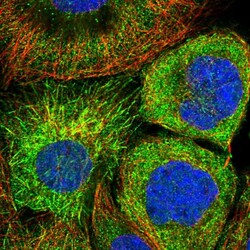HPA042027
antibody from Atlas Antibodies
Targeting: KNSTRN
C15orf23, FLJ14502, kinastrin, SKAP, TRAF4AF1
Antibody data
- Antibody Data
- Antigen structure
- References [9]
- Comments [0]
- Validations
- Immunocytochemistry [1]
Submit
Validation data
Reference
Comment
Report error
- Product number
- HPA042027 - Provider product page

- Provider
- Atlas Antibodies
- Proper citation
- Atlas Antibodies Cat#HPA042027, RRID:AB_10797378
- Product name
- Anti-KNSTRN
- Antibody type
- Polyclonal
- Description
- Polyclonal Antibody against Human KNSTRN, Gene description: kinetochore-localized astrin/SPAG5 binding protein, Alternative Gene Names: C15orf23, FLJ14502, kinastrin, SKAP, TRAF4AF1, Validated applications: IHC, ICC, Uniprot ID: Q9Y448, Storage: Store at +4°C for short term storage. Long time storage is recommended at -20°C.
- Reactivity
- Human
- Host
- Rabbit
- Conjugate
- Unconjugated
- Isotype
- IgG
- Vial size
- 100 µl
- Concentration
- 0.4 mg/ml
- Storage
- Store at +4°C for short term storage. Long time storage is recommended at -20°C.
- Handling
- The antibody solution should be gently mixed before use.
Submitted references Search for chromosomal instability aiding variants reveal naturally occurring kinetochore gene variants that perturb chromosome segregation
Endomembranes promote chromosome missegregation by ensheathing misaligned chromosomes.
Counteraction between Astrin-PP1 and Cyclin-B-CDK1 pathways protects chromosome-microtubule attachments independent of biorientation
DIAPH3 deficiency links microtubules to mitotic errors, defective neurogenesis, and brain dysfunction
Kinetochores attached to microtubule-ends are stabilised by Astrin bound PP1 to ensure proper chromosome segregation
Aurora-B kinase pathway controls the lateral to end-on conversion of kinetochore-microtubule attachments in human cells
Phosphorylation of Astrin Regulates Its Kinetochore Function.
A proteomic study of mitotic phase-specific interactors of EB1 reveals a role for SXIP-mediated protein interactions in anaphase onset
Lateral to End-on Conversion of Chromosome-Microtubule Attachment Requires Kinesins CENP-E and MCAK
Islam A, Manjarrez-González J, Song X, Gore T, Draviam V
iScience 2024;27(3):109007
iScience 2024;27(3):109007
Endomembranes promote chromosome missegregation by ensheathing misaligned chromosomes.
Ferrandiz N, Downie L, Starling GP, Royle SJ
The Journal of cell biology 2022 Jun 6;221(6)
The Journal of cell biology 2022 Jun 6;221(6)
Counteraction between Astrin-PP1 and Cyclin-B-CDK1 pathways protects chromosome-microtubule attachments independent of biorientation
Song X, Conti D, Shrestha R, Braun D, Draviam V
Nature Communications 2021;12(1)
Nature Communications 2021;12(1)
DIAPH3 deficiency links microtubules to mitotic errors, defective neurogenesis, and brain dysfunction
Lau E, Damiani D, Chehade G, Ruiz-Reig N, Saade R, Jossin Y, Aittaleb M, Schakman O, Tajeddine N, Gailly P, Tissir F
eLife 2021;10
eLife 2021;10
Kinetochores attached to microtubule-ends are stabilised by Astrin bound PP1 to ensure proper chromosome segregation
Conti D, Gul P, Islam A, Martín-Durán J, Pickersgill R, Draviam V
eLife 2019;8
eLife 2019;8
Aurora-B kinase pathway controls the lateral to end-on conversion of kinetochore-microtubule attachments in human cells
Shrestha R, Conti D, Tamura N, Braun D, Ramalingam R, Cieslinski K, Ries J, Draviam V
Nature Communications 2017;8(1)
Nature Communications 2017;8(1)
Phosphorylation of Astrin Regulates Its Kinetochore Function.
Chung HJ, Park JE, Lee NS, Kim H, Jang CY
The Journal of biological chemistry 2016 Aug 19;291(34):17579-92
The Journal of biological chemistry 2016 Aug 19;291(34):17579-92
A proteomic study of mitotic phase-specific interactors of EB1 reveals a role for SXIP-mediated protein interactions in anaphase onset
Tamura N, Simon J, Nayak A, Shenoy R, Hiroi N, Boilot V, Funahashi A, Draviam V
Biology Open 2015;4(2):155-169
Biology Open 2015;4(2):155-169
Lateral to End-on Conversion of Chromosome-Microtubule Attachment Requires Kinesins CENP-E and MCAK
Shrestha R, Draviam V
Current Biology 2013;23(16):1514-1526
Current Biology 2013;23(16):1514-1526
No comments: Submit comment
Supportive validation
- Submitted by
- Atlas Antibodies (provider)
- Main image

- Experimental details
- Immunofluorescent staining of human cell line A-431 shows localization to cytosol & microtubules.
- Sample type
- Human
 Explore
Explore Validate
Validate Learn
Learn Immunocytochemistry
Immunocytochemistry Immunohistochemistry
Immunohistochemistry